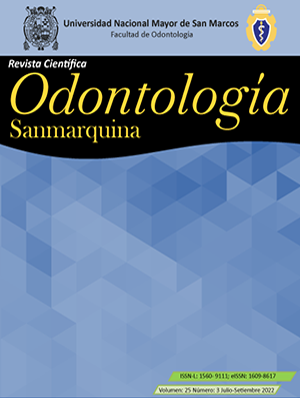Dental trauma in a patient with autism spectrum disorder. Clinical case report
DOI:
https://doi.org/10.15381/os.v25i3.23207Keywords:
Autism spectrum disorder, Endodontics, Humanization of assistance, Seizures; Tooth injuriesAbstract
A 12-year-old girl diagnosed with autism spectrum disorder (ASD), epilepsy, and intellectual deficit, was seen at the dental clinic for patients with special needs at the Dental School of the Federal University of Rio Grande do Sul, due to a gingival hemorrhage on tooth 21, after a fall due to a seizure. The clinical examination of the patient identified active caries and the presence of visible biofilm on almost all dental surfaces. A radiographic exam of tooth 21 showed a fracture in the middle-third root of the tooth. All the necessary dental procedures were carried out during the endodontic treatment on tooth 21, filling the canal with calcium hydroxide paste. During the beginning of the care, the patient presented an agitated behavior requiring specialized management, always keeping the caregiver in the same clinical setting so that the patient felt welcomed. It concluded the knowledge of the particularities of the patient-reported with ASD was of utmost importance for the conduct of her dental treatment, enabling appropriate behaviors in her rehabilitation.
Downloads
Downloads
Published
Issue
Section
License
Copyright (c) 2022 Márcia Cançado Figueiredo, Laura Pasqualini Berti, Judith Liberman Perlmuter, Daiana Back Gouvêa, Andressa Nicoli Haas

This work is licensed under a Creative Commons Attribution 4.0 International License.
AUTHORS RETAIN THEIR RIGHTS:
a. Authors retain their trade mark rights and patent, and also on any process or procedure described in the article.
b. Authors retain their right to share, copy, distribute, perform and publicly communicate their article (eg, to place their article in an institutional repository or publish it in a book), with an acknowledgment of its initial publication in the Odontología Sanmarquina.
c. Authors retain theirs right to make a subsequent publication of their work, to use the article or any part thereof (eg a compilation of his papers, lecture notes, thesis, or a book), always indicating the source of publication (the originator of the work, journal, volume, number and date).






